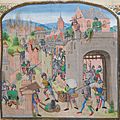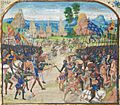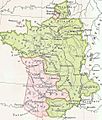Battle of Poitiers facts for kids
The Battle of Poitiers can mean two important battles in history:
- The Battle of Tours (732), sometimes called the Battle of Poitiers, fought between Frankish (French) and Islamic armies.
- The Battle of Poitiers (1356), a major battle between England and France during the Hundred Years' War.
This article will focus on the Battle of Poitiers from 1356, which was a very important event in the long war between England and France.
Contents
The Hundred Years' War: A Quick Look
The Hundred Years' War was a series of conflicts between the Kingdom of England and the Kingdom of France that lasted for more than 100 years, from 1337 to 1453. It wasn't one continuous battle, but many battles and truces. The main reason for the war was that English kings claimed the throne of France.
Who Was Fighting?
On the English side, the main leader was Edward, the Black Prince, who was the eldest son of King Edward III of England. He was a skilled military commander. On the French side, the army was led by King John II of France, also known as John the Good.
Leading Up to the Battle
In 1356, the Black Prince led his army on a "chevauchée" (pronounced she-vo-SHAY) through France. This was a military raid where armies would march through enemy territory, taking supplies, burning towns, and causing damage. The goal was to weaken the enemy and force them into battle.
The Black Prince's Campaign
The Black Prince's army marched north from Bordeaux, raiding towns and villages. They gathered a lot of treasure and supplies. King John II of France gathered a much larger army to stop them. He wanted to catch the English army before they could return to their safe territory.
The Armies Meet
The two armies finally met near Poitiers, a city in western France. The English army was smaller, with about 6,000 to 7,000 soldiers. The French army was much larger, possibly around 15,000 to 20,000 men.
The Battle of Poitiers (1356)
The battle took place on September 19, 1356. The English army took up a strong defensive position on a ridge, surrounded by hedges and vineyards. This made it difficult for the larger French army to attack them all at once.
English Tactics
The English used their famous longbowmen very effectively. These archers could shoot arrows quickly and with great force, even through armor. Many English knights and men-at-arms fought on foot alongside the archers, which was a common English tactic at the time.
French Attacks
The French knights, eager to prove their bravery, launched several charges. However, the narrow paths and the deadly arrows from the English longbows caused heavy losses. The French struggled to break through the English lines.
The Turning Point
As the battle continued, the French army became disorganized. The Black Prince saw an opportunity. He ordered a small group of cavalry to ride around the French flank (the side of their army) and attack from behind. This surprise attack, combined with a general advance by the English main force, caused panic among the French.
King John II Captured
The French army began to retreat, and soon it turned into a full rout. Many French soldiers fled. King John II of France fought bravely but was eventually surrounded and captured by the English. This was a huge blow to France.
Aftermath of the Battle
The Battle of Poitiers was a massive victory for the English. It showed the effectiveness of the longbow and the tactical skill of the Black Prince.
Consequences for France
The capture of King John II was a disaster for France. It led to political chaos and instability. France had to pay a huge ransom to get their king back.
The Treaty of Brétigny
The battle eventually led to the Treaty of Brétigny in 1360. This treaty gave England control over a large part of French territory and temporarily ended the first phase of the Hundred Years' War. However, the peace did not last forever.
The Battle of Poitiers remains one of the most famous battles of the Hundred Years' War, remembered for its surprising outcome and the capture of a king.
Images for kids
-
A modern replica of a bodkin point arrowhead used by English longbows to penetrate armour -
France after the 1360 Treaty of Brétigny; French territory in green, English territory in pink
See also
In Spanish: Batalla de Poitiers (1356) para niños











